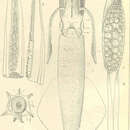Loliginidae: Brief Summary
provided by wikipedia EN
Loliginidae, commonly known as pencil squids, is an aquatic family of squid classified in the order Myopsida.
- license
- cc-by-sa-3.0
- copyright
- Wikipedia authors and editors
Description
provided by World Register of Marine Species
Shape variable from short and stout to long and slender. Fins terminal or marginal, but always united posteriorly; funnel-locking apparatus a simple, straight groove. Eyes covered with transparent skin (corneal membrane); buccal connectives attached to ventral borders of fourth arms; 7 buccal lappets supplied with small suckers (except in Lolliguncula and Alloteuthis); 8 arms and 2 tentacles around mouth; 2 rows of suckers on arms and 4 rows on tentacular clubs, hooks never present. Usually the left arm of the IV (ventral) pair is hectocotylized in males (used to transfer sperm packets from the male to the female); the structure of the modified portion (hectocotylus) of the arm is useful in most species as a diagnostic character (often, the suckers on the hectocotylus are reduced in size or number, or modified into fleshy papillae or flaps (lamellae), or they disappear altogether. Colour: usually reddish-brown, darker dorsally, but quite variable depending on the behavioural situation.
MASDEA (1997).
- license
- cc-by-4.0
- copyright
- WoRMS Editorial Board


